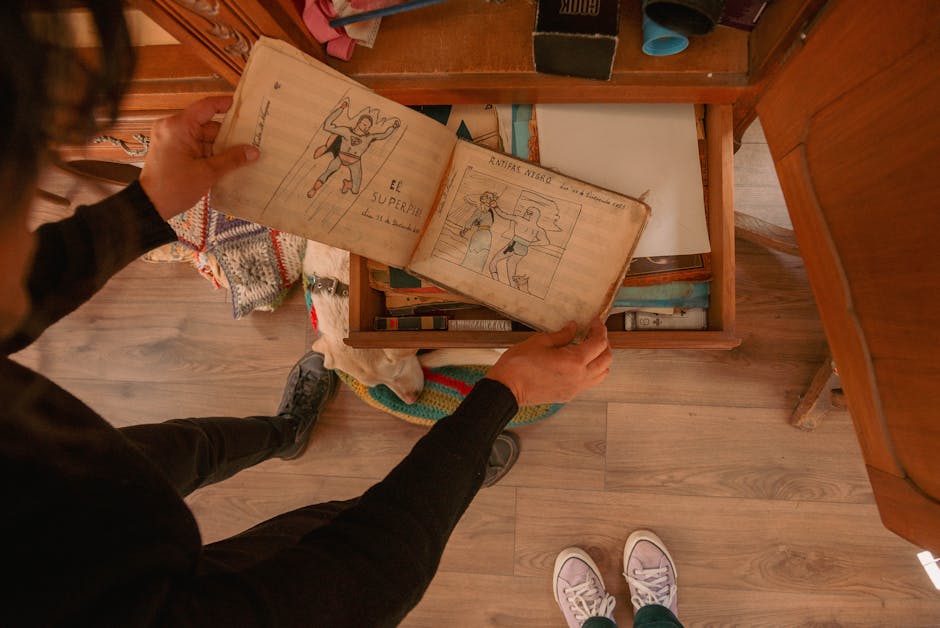😳 How to Make your FIRST Manga | Beginner Mangaka Tutorial

😳 How to Make your FIRST Manga | Beginner Mangaka Tutorial
Konnichiwa, manga enthusiasts! So, you're dreaming of creating your very own manga, huh? That's fantastic! The world of storytelling through illustrated panels is incredibly rewarding, and I'm thrilled to guide you on your first steps towards becoming a mangaka. Don't worry if it feels a bit daunting right now. We'll break it down into manageable steps, sprinkled with a dash of Japanese design philosophy for good measure. Think wabi-sabi – embracing imperfection and finding beauty in the unique journey.
The first manga is always the most challenging, but also the most exciting. It's a journey of discovery, both in terms of your artistic skills and your storytelling voice. Remember, even legendary mangaka like Osamu Tezuka (the "God of Manga" himself!) started somewhere.
So, grab your pencils (or your stylus!), and let's embark on this creative adventure together!
1. The Spark: Finding Your Story

Before you even think about drawing, you need a story! This is the heart and soul of your manga. It doesn't have to be groundbreaking, but it should be something you're passionate about. Think about what truly excites you:
a. Genre Exploration: What kind of stories do you love to read and watch? Shonen (action-adventure), shojo (romance), seinen (targeting older men), josei (targeting older women), slice-of-life, fantasy, sci-fi... the possibilities are endless! Understanding different genres will help you tailor your story and art style accordingly.
b. Brainstorming Session: Grab a notebook and just let your ideas flow. No editing, no judgment – just write down everything that comes to mind. Think about: 1. Characters: Who are your main characters? What are their strengths, weaknesses, and motivations? 2. Setting: Where does your story take place? Is it a fantastical world, a historical setting, or modern-day Japan? 3. Plot: What is the central conflict? What are the key events that will drive the story forward? 4. Theme: What message do you want to convey through your manga? What larger ideas are you exploring?
c. Inspiration is Everywhere: Look to your favorite manga, anime, books, movies, and even real-life experiences for inspiration. However, remember that inspiration is different from copying. Use these sources as a springboard for your own unique ideas. Think about the Japanese concept of mitate, which involves subtly reinterpreting and drawing inspiration from existing motifs.
d. Keep it Simple (at First): For your first manga, I highly recommend starting with a shorter story – perhaps a one-shot (a single chapter) or a very short series. This will allow you to focus on mastering the fundamentals without getting overwhelmed by a massive project. Think of it as creating a beautiful haiku instead of a sprawling epic poem.
2. Crafting the Narrative: Storyboarding & Scripting

Once you have a solid story idea, it's time to flesh it out into a detailed narrative. This involves scripting and storyboarding.
a. Writing the Script: 1. Outline: Create a scene-by-scene outline of your story. This will serve as your roadmap. 2. Dialogue: Write the dialogue for each scene. Consider your characters' personalities and how they would naturally speak. Remember, dialogue should advance the plot and reveal character. 3. Descriptions: Include brief descriptions of the setting, character actions, and any important visual cues.
b. Storyboarding: This is where you visually plan out each page of your manga. Think of it like a rough draft of your panels. 1. Panel Layout: Sketch out the arrangement of panels on each page. Consider the flow and pacing of the story. Experiment with different panel sizes and shapes to create visual interest. Japanese manga often uses dynamic panel layouts to heighten the emotional impact. 2. Composition: Draw rough sketches of what each panel will contain – characters, backgrounds, and action. Focus on the composition of each panel. Where will your characters be placed? What is the focal point of the panel? 3. Action Lines & Sound Effects: Indicate the direction of movement with action lines and add sound effects (onomatopoeia) to enhance the visual storytelling. Manga is famous for its expressive use of sound effects! 4. Dialogue Balloons: Add dialogue balloons to each panel, indicating what characters are saying. 5. Iteration: Don't be afraid to revise your storyboard. This is a crucial step in refining your story and ensuring it flows smoothly.
Think of storyboarding as the architectural blueprint of your manga. It helps you visualize the entire story before you commit to the final artwork.
3. Mastering the Art: Character Design & Drawing Techniques

Now for the fun part! It's time to bring your characters and world to life through your art.
a. Character Design: 1. Silhouette: Start with the basic silhouette of your character. This will help you establish their overall shape and personality. 2. Anatomy: Learn the fundamentals of anatomy. While manga characters often have exaggerated proportions, a basic understanding of anatomy is essential. 3. Facial Expressions: Facial expressions are key to conveying emotions. Study different expressions and practice drawing them. Pay attention to the eyes, eyebrows, and mouth. 4. Clothing: Design clothing that reflects your characters' personalities and the setting of your story. Consider the practical aspects of the clothing as well. 5. Consistency: Maintain consistency in your character designs throughout the manga. This will help your readers connect with the characters and believe in your world.
b. Drawing Techniques: 1. Pencils & Inking: Practice your pencil sketching skills. Focus on creating clean lines and dynamic poses. Once you're happy with your pencil drawing, you can ink it using pens or digital tools. Inking is crucial for creating a professional-looking manga. Experiment with different pen sizes and techniques to achieve different effects. 2. Line Weight: Vary the line weight of your drawings to create depth and visual interest. Thicker lines can be used to outline characters and objects, while thinner lines can be used for details and shading. 3. Screen Tones: Screen tones (also known as halftone patterns) are used to add shading and texture to your manga. You can use physical screen tone sheets or digital screen tones in programs like Clip Studio Paint. Screen tones are a staple of manga art and can greatly enhance the visual impact of your pages. 4. Backgrounds: Don't neglect your backgrounds! Backgrounds help to establish the setting and create a sense of atmosphere. Learn perspective drawing to create realistic and immersive backgrounds. 5. Practice, Practice, Practice: The key to improving your drawing skills is consistent practice. Dedicate time each day to drawing and experimenting with different techniques. Don't be afraid to make mistakes – they're a part of the learning process!
Remember the Japanese aesthetic of yugen – a profound, mysterious beauty that hints at something beyond the surface. Strive to capture that essence in your artwork.
4. Bringing it All Together: Creating the Manga Pages

Now that you have your story, script, storyboard, and character designs, it's time to create the actual manga pages.
a. Page Layout: Use your storyboard as a guide to create the final page layout. Make sure the panels are arranged in a logical and visually appealing way. Consider the flow of the story and the pacing of each scene.
b. Penciling, Inking, and Toning: Draw the final artwork for each panel, using your pencil sketches as a reference. Ink your drawings carefully, paying attention to line weight and detail. Add screen tones to create shading and texture.
c. Adding Dialogue and Sound Effects: Add the dialogue balloons and sound effects to each panel. Make sure the text is legible and that the balloons are placed in a way that doesn't obscure the artwork.
d. Digital vs. Traditional: You can create your manga pages either digitally or traditionally. Digital tools like Clip Studio Paint offer a wide range of features specifically designed for creating manga, while traditional methods using paper, pencils, and inks offer a more tactile and hands-on experience. Choose the method that works best for you.
5. Editing & Refining: Polishing Your Work

Once you've completed your manga pages, it's important to edit and refine your work.
a. Proofreading: Carefully proofread your dialogue and sound effects for any typos or grammatical errors.
b. Visual Consistency: Check for visual consistency throughout your manga. Are your characters drawn consistently? Are the backgrounds consistent with the setting?
c. Feedback: Ask friends, family, or other artists to review your manga and provide feedback. Be open to criticism and use it to improve your work. Online manga communities can be a great resource for getting feedback.
d. Revision: Based on the feedback you receive, revise your manga pages as needed.
6. Sharing Your Manga: Reaching Your Audience

Congratulations! You've created your first manga! Now it's time to share it with the world.
a. Online Platforms: There are many online platforms where you can publish your manga for free, such as: 1. Webtoons: A popular platform for webcomics and manga. 2. Tapas: Another great platform for publishing your manga. 3. DeviantArt: A general art community where you can share your manga. 4. Your Own Website: Creating your own website or blog gives you complete control over your manga's presentation.
b. Social Media: Promote your manga on social media platforms like Twitter, Instagram, and Facebook. Use relevant hashtags to reach a wider audience.
c. Conventions & Events: Attend manga conventions and art events to showcase your work and connect with other artists and fans.
d. Self-Publishing: Consider self-publishing your manga as a physical book. This can be a rewarding experience, but it also requires a significant investment of time and money.
Embrace the Journey: Kaizen in Action

Creating a manga is a continuous learning process. Don't be discouraged if your first manga isn't perfect. Embrace the Japanese concept of kaizen – continuous improvement. Learn from your mistakes, keep practicing, and never stop experimenting.
Remember, the most important thing is to have fun and express your creativity! Ganbatte (do your best)! And who knows, maybe your manga will become the next big hit! じゃあまた (Ja mata! See you later!).
Post a Comment